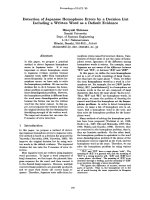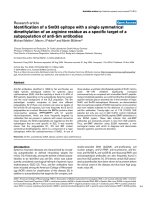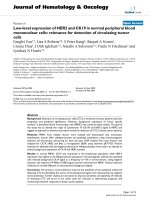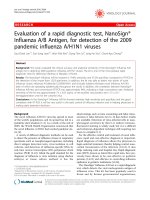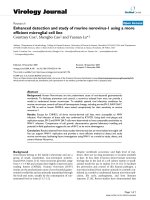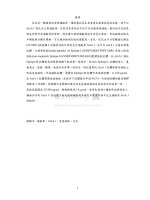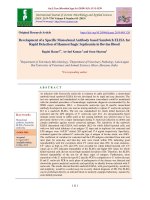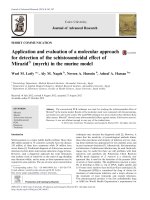detection of circulating norovirus genotypes hitting a moving target
Bạn đang xem bản rút gọn của tài liệu. Xem và tải ngay bản đầy đủ của tài liệu tại đây (1.05 MB, 7 trang )
Rooney et al. Virology Journal 2014, 11:129
/>
RESEARCH
Open Access
Detection of circulating norovirus genotypes:
hitting a moving target
Brenda-Lee Rooney1,2, Janice Pettipas2, Elsie Grudeski3, Oksana Mykytczuk4, Xiao-Li Pang5,6, Tim F Booth3,
Todd F Hatchette1,2 and Jason J LeBlanc1,2*
Abstract
Background: Although national surveillance programs are in place to monitor norovirus epidemiology, the
emergence of new strains and the genetic diversity among genotypes can be challenging for clinical laboratories.
This study evaluated the analytical and clinical performance characteristics of one real-time RT-PCR and two end-point
RT-PCRs commonly used in microbiology laboratories.
Methods: Lower limit of detection (LoD) was determined using 10-fold dilutions of noroviruses belonging to different
genotypes. The clinical performance of the real-time and end-point RT-PCRs was assessed in parallel using nucleic acids
extracted from 186 stool specimens.
Results: The real-time RT-PCR was highly sensitive and specific for the detection of norovirus genotypes that are
currently circulating in Canada. In contrast, the two end-point RT-PCRs displayed poor analytical sensitivity or complete
failure to detect certain norovirus genotypes, which was correlated to sequence mismatches in the primer-binding sites.
In an attempt to improve norovirus detection with the end-point RT-PCRs, both assays were processed concurrently and
detection from either assay was considered a positive result. Concurrent testing resulted in only a modest increase in
clinical sensitivity (75.0%) compared to each assay alone (62.5% and 71.9%). However, the false positivity rate increased
from 1.98% and 3.36% for the assays alone to 5.47% with concurrent testing.
Conclusions: This study emphasizes the benefits of a real-time method and provides support for routine surveillance to
monitor norovirus epidemiology and ongoing proficiency testing to ensure detection of circulating norovirus genotypes.
Keywords: Norovirus, Proficiency testing, Quantitative RT-PCR, Epidemiology, Genotyping
Background
Noroviruses are the leading cause of acute gastroenteritis, and outbreaks are common [1,2]. Transmission occurs through the fecal-oral route and is facilitated by a
low infectious dose and environmental persistence [1,2].
Laboratory identification of norovirus can help reduce
transmission through infection control and public health
interventions [2]. Since human noroviruses are uncultivable, traditional detection methods relied primarily on
electron microscopy and enzyme immunoassays, both of
which lack sensitivity [2-5]. RT-PCR has markedly improved the detection of noroviruses and has become the
* Correspondence:
1
Dalhousie University, Halifax, Nova Scotia, Canada
2
Division of Microbiology, Department of Pathology and Laboratory
Medicine, Capital District Health Authority (CDHA), Dalhousie University,
Halifax, Nova Scotia, Canada
Full list of author information is available at the end of the article
method of choice for clinical diagnosis [2]. However, the
genetic diversity among noroviruses poses a particular
challenge for molecular assays [6-11]. Noroviruses are
classified into six genogroups, three of which cause human disease (GI, GII, and GIV) [12-14]. The two predominant genogroups, GI and GII, are further subdivided
into 9 and 22 genotypes, respectively [12-14]. Strategies
used to overcome norovirus diversity have included the
simultaneous use of various monoplex RT-PCRs, multiplexed RT-PCRs, RT-PCRs with degenerate primers and
probes [8-11,15-19].
The dynamic nature of its epidemiology poses further
challenges for laboratory detection of norovirus. While
genotype GII.4 is responsible for the majority of outbreaks annually, new GII.4 strains emerge every 2–3 years
that replace the previously circulating pandemic strain
[14,20-25]. Norovirus GII.4-2012 Sydney has recently
© 2014 Rooney et al.; licensee BioMed Central Ltd. This is an Open Access article distributed under the terms of the Creative
Commons Attribution License ( which permits unrestricted use, distribution, and
reproduction in any medium, provided the original work is properly credited. The Creative Commons Public Domain
Dedication waiver ( applies to the data made available in this article,
unless otherwise stated.
Rooney et al. Virology Journal 2014, 11:129
/>
Page 2 of 7
emerged and replaced GII.4-2009 New Orleans worldwide [14,20-26], including the Canadian provinces of
Alberta [25], British Columbia [27] and recently, Nova
Scotia (unpublished data). In addition, the proportion of
outbreaks associated with non-GII.4 genotypes has increased in Canada and the US, and the predominant nonGII.4 genotypes change over time [14,23,25,28]. With the
diversity among norovirus genotypes and the dynamic nature of its epidemiology, this study evaluated the analytical
and clinical performance of a real-time RT-PCR and two
end-point RT-PCRs (EP-SR and EP-JV) commonly used
for the detection of noroviruses in clinical, food and environmental laboratories [8-11,16,17,29-36].
Results
Analytical sensitivity and specificity
Each method was specific for circulating noroviruses
(Table 1) and no cross-reactions occurred with various
enteric pathogens. The real-time RT-PCR was able to
detect all norovirus genotypes with high sensitivity
(Table 1). EP-JV detected all GII.4 strains, but only a
subset of non-GII.4 genotypes. EP-SR only detected
GII.4 strains. For GII.4 noroviruses, real-time RT-PCR
was approximately 10-fold more sensitive than EP-JV,
and 100-fold more sensitive than EP-SR (Table 1). Similarly, the LoD for different GII.4 strains were highly
consistent for EP-JV. For EP-SR, only minor differences in the LoD for GII.4 strains from 2004 to 2009,
but a 100-fold decrease in sensitivity was observed for
Table 1 Limit of detection and specificity analysis
Genotype
Estimated analytical sensitivity
[Log10 (copies/ml)]
Real-time
EP-JV
EP-SR
RT-PCR
RT-PCR
RT-PCR
GI.1 (2011)
2.21
ND*
ND
GI.3 (2008)
2.27
ND
ND
GI.4 (2008)
2.67
ND
ND
GI.6 (2010)
2.11
5.96
ND
GII.1 (2011)
2.37
5.54
ND
GII.3 (2006)
2.52
ND
ND
GII.7 (2010)
2.57
ND
ND
GII.13 (2010)
2.14
ND
ND
GII.4 (2004) Den Haag
2.20
3.56
4.55
GII.4 (2006b) Osaka
2.47
3.37
4.32
Norovirus, genotype GI
Norovirus, genotype GII (non-GII.4)
Norovirus, genotype GII.4
GII.4 (2009) New Orleans
2.85
3.53
4.52
GII.4 (2012) Sydney
2.61
3.71
6.62
*ND signifies not detected at a minimal concentration of 106 copies/ml.
GII.4-2012. Reduced sensitivity was also observed with
EP-JV for genotypes GI.6 and GII.1.
Clinical evaluation
The clinical sensitivity of the real-time RT-PCR and
end-point RT-PCR assays (EP-JV and EP-SR) was 100%,
71.9%, and 62.5%, respectively (Table 2). With concurrent testing of EP-JV and EP-SR, the clinical sensitivity
was only modestly increased to 75% compared to each
assay alone, since both EP-JV and EP-SR failed to detect
8 genotype GII.7 noroviruses (Table 3). EP-JV alone also
missed a genotype GII.15 and EP-SR missed three genotype GI.6 noroviruses and one GI.3 (Table 3). With the
exception of the latter, viral loads were above their LoD
for all methods and the poor sensitivity of EP-JV and
EP-SR was correlated to sequence mismatches in the
primer-binding sites (Table 1 and Figure 1).
As non-specific amplifications were observed for both
EP-JV and EP-SR, concurrent testing resulted in a reduced clinical specificity (94.8%) compared to each
method alone (98.1% and 96.8%, respectively) (Table 2).
The false positivity rate for concurrent testing was
increased to 5.47% compared to 1.98% and 3.36% for
EP-JV and EP-SR alone. A two-year retrospective analysis revealed that 14 outbreaks were declared by a single
EP-JV and EP-SR result where weak amplifications were
noted, suggesting a possible false positivity rate of 4.8%
for years 2011 and 2012 (Additional file 1: Table S2). As
no differences were observed between real-time RT-PCR
and the reference methods, the real-time RT-PCR was
highly specific (100%) and no false positives were observed (Tables 2 and 3).
Discussion
Genomic diversity and evolutionary change can be challenging for detection of noroviruses [2,37,38]. While detection of noroviruses using RT-PCR is far more accurate
than antigen-based detection methods (i.e. EIAs), not all
molecular methods are created equal [2-4]. Fortunately,
most reference laboratories use a real-time RT-PCR targeting the most conserved region of the genome (ORF1ORF2 junction) and use degenerate primers and probes
that can tolerate some sequence mismatches [9,10]
(Figure 1). In this study, this same real-time RT-PCR was
able to detect diverse norovirus genotypes with analytical
sensitivities consistent with values previously reported
for GII.4 (2006b) (Table 1) [6]. In contrast, EP-JV and
EP-SR were far less sensitive and failed to detect certain
genotypes (Tables 1, 2 and 3). With hopes to enhance
detection of circulating norovirus genotypes, EP-JV and
EP-SR were processed concurrently and detection from
either assay was considered a positive result. Concurrent testing only modestly improved clinical sensitivity
(Table 2) since the majority of false negative results
Rooney et al. Virology Journal 2014, 11:129
/>
Page 3 of 7
Table 2 Clinical performance characteristics compared to the modified gold standard
Method
Clinical Parameters*
Real-time RT-PCR
Sensitivity (%)
Specificity (%)
Kappa
False positivity rate (%)
100.0 (91.5 – 100.0)
100.0 (98.2 – 100.0)
1.00 (0.90 – 1.00)
0.00
EP-JV
71.9 (58.6 – 71.9)
98.1 (95.3 – 99.5)
0.76 (0.58 – 0.84)
1.99
EP-SR
62.5 (48.4 – 71.7)
96.8 (93.8 – 98.7)
0.65 (0.46 – 0.77)
3.36
EP-JV and EP-SR
75.0 (60.3 – 85.5)
94.8 (91.7 – 97.0)
0.70 (0.52 – 0.82)
5.47
*When applicable, 95% confidence intervals are indicated in parentheses.
were common between both EP-JV and EP-SR (Table 3).
Interestingly, failure of EP-JV and EP-SR to detect certain genotypes was not attributed to poor analytical
sensitivity since the viral load in most clinical specimens
far exceeded the LoD for each assay (Tables 1 and 3). Instead, the genotypes that failed to be detected for EP-JV
(GII.7, GII.15) and EP-SR (GII.7, GI.6, and GI.3) were
linked to several sequence mismatches in the primerbinding sites (Figure 1). Of note, a large norovirus outbreak in Sweden was missed due to mismatches in the
primer-binding sites of JV12 and JV13 (same used for
EP-JV), but were detected by another primer pair [31].
It should also be noted that real-time RT-PCR and
EP-JV both detected genotype GI.3 in a specimen with
a very low viral load (2.47 log10 copies/ml), whereas
EP-JV were unable to detect this genotype at concentrations exceeding 6.0 log10 copies/ml in the specificity
analysis (Tables 1 and 3). This confounding result might
be explained by genetic differences between the norovirus GI.3 identified in the clinical evaluation and the one
used for the specificity analysis. A 12% nucleotide difference was noted between GI.6 and GI.7 genotypes that
circulated in Canada between 2009 and 2010 compared
to 2012 and 2013, suggesting that diversity among the
same genotype can occur over time [24]. It is also possible that the faint amplicon detected by EP-JV was a
false positive result in a specimen that was coincidently
positive by real-time RT-PCR (Table 3).
While concurrent testing marginally increased the clinical sensitivity, a reciprocal effect was seen on the clinical
specificity where the false positivity rate was higher with
concurrent testing (5.47%) than either method alone
(1.98% and 3.36% for EP-JV and EP-SR, respectively)
(Table 2). Upon review of the false positive results, only
faint or non-specific amplifications were noted and likely
attributed to the low annealing temperature of EP-JV
(37°C) or lack of electrophoretic resolution between
primer dimmers and the small amplicon generated with
EP-SR of 123 bp. The subjectivity of gel resolution is
not a problem for a properly validated real-time RTPCR [9,10,39].
Following a two-year retrospective analysis of EP-JV
and EP-SR results, 14 of 113 outbreaks investigated in
2011 and 2012 were declared positive by a single result
where weak amplification was observed (Additional file 1:
Table S2). This supports the high false positivity rate
observed during the clinical evaluation (Table 2). Previous studies have demonstrated that three specimens are
ideal for the detection of norovirus outbreaks using RTPCR, but excessive testing can lead to reduced specificity
[5,40,41]. In this study, concurrent testing with multiple
RT-PCRs was shown to increase the rate of false positive
results, which could prematurely halt outbreak investigations caused by other enteric pathogens that might be
managed differently [2].
Conclusions
Unlike the high clinical sensitivity and specificity observed with real-time RT-PCR, this study demonstrated
that end-point RT-PCRs had poor accuracy for the detection of circulating norovirus genotypes. To monitor norovirus epidemiology, genotyping should be considered
Table 3 Discordant results obtained during the clinical evaluation
No.
RT-PCR results
Discordant analysis
Interpretation
Comments
Real-time RT-PCR
EP-JV
EP-SR
Result
Genotype
5
Neg.
Neg.
Pos.
Neg.
N/A
3
Neg.
Pos.
Neg.
FP (EP-SR)
Non-specific amplification
Neg.
N/A
FP (EP-JV)
Non-specific amplification
8
Pos.
Neg.
3
Pos.
Pos.
Neg.
Pos.
GII.7
FN (EP-JV and EP-SR)
High viral loads (5.28 to 7.78 log10 copies/ml)
Neg.
Pos.
GI.6
FN (EP-SR)
High viral loads (5.29 to 5.74 log10 copies/ml)
1
Pos.
1
Pos.
Pos.
Neg.
Pos.
GI.3
FN (EP-SR)
Low viral load (2.47 log10 copies/ml)
Neg.
Pos.
Pos.
GII.15
FN (EP-JV)
High viral load (6.33 log10 copies/ml)
Abbreviations: FN false negative, FP false positive, N/A not applicable, Neg. Negative, No. number, Pos. positive.
Rooney et al. Virology Journal 2014, 11:129
/>
Page 4 of 7
Figure 1 Sequence alignment of the primer and probe binding sites. Primer pairs JV12/JV13 and SR33/SR46 are A) endpoint RT-PCR assays;
B) real-time RT-PCR. Mismatches between the primer/probe sequences are indicated by a shaded font and are underlined. Genbank accession
numbers are as follows: GI.1 (2011), KF039733.1; GI.3 (2008), JN603244.1; GI.4 (2008), JN603245.1; GI.6 (2010), JQ388274.1; GII.1 (2011), KC597150.1;
GII.3 (2006), GU980585.1; GII.7 (2010), JQ750988.1; GII.13 (2010), JX439807.1; GII.4 (2004), JQ798158.1; GII.4 (2006b), AB447442.1; GII.4 (2009),
GU445325.2; GII.4 (2012), JX459908.1. Abbreviations: B = C, G, or T; R = A or G; Y = C or T; I = A, C, G, or T.
part of routine outbreak investigations when norovirus is
identified as the etiological agent. Unlike well established
networks like Calicinet and Noronet, norovirus surveillance in Canada is in its infancy [2,14]. Ideally, sequencing
would be used to encompass the regions required for
genotyping and the primer/probe-binding sites for commonly used RT-PCRs [42,43]. When sequence mismatches
are identified in RT-PCR target regions or when new norovirus variants emerges, proficiency panels should be
promptly disseminated to clinical laboratories to ensure
accurate detection [6]. With the dynamic nature of norovirus epidemiology, this study highlights the importance
of routine surveillance and ongoing proficiency testing for
circulating norovirus genotypes.
Materials and methods
Specimen preparation
For the clinical evaluation, 186 stool specimens were obtained from patients with acute gastroenteritis between
March 15 and June 26, 2013. Public Health outbreak
investigation data was provided by the Department of
Health and Wellness (Halifax, NS) (Additional file 1:
Table S2). Stool slurries were prepared by transferring
200 μl of stool into 500 μl of PCR-grade water and centrifugation (10,000 × g, 10 min). The supernatants (140 μl)
were subjected to a total nucleic acid (TNA) extraction
on a MagNA Pure LC instrument (Roche Diagnostics,
Branchburg, NJ), as recommended by the manufacturer.
TNAs were eluted in a volume of 60 μl and 5 μl served as
Rooney et al. Virology Journal 2014, 11:129
/>
template for all molecular assays (which were processed
in parallel). Primers were synthesized by Sigma Genosys
(Oakville, ON) and probes by Integrated DNA Technologies (Toronto, ON).
Analytical specificity was performed using high titer
total nucleic acids extracted from norovirus stool suspensions of various genotypes obtained from collaborating
laboratories and concentrated suspensions (MacFarlane
value of 2.0) of various enteric pathogens that included:
adenovirus type 40 (ATCC VR-931); Camplobacter
jejeuni (ATCC 33291); Clostridium difficile (ATCC
9689); Escherichia coli O157:H7 (ATCC 35150); Rotavirus A (ATCC VR-2018); Salmonella enterica serovar
Typhymirium (ATCC 14028); sapovirus (5 clinical isolates);
Shigella flexneri (ATCC 12022); Shigella dysenteriae
(ATCC 13313); Yersinia enterocolitica (ATCC 9610);
Vibrio cholerae (clinical isolate). To assess the LoD,
10-fold serial dilutions of nucleic acids extracted from
various norovirus genotypes were performed on specimens that had a minimum concentration of 106 copies/
ml. LoD was defined at a probability of 95% using Probit
analysis [44] with replicate values obtained in three independent experiments (n = 9).
End-point RT-PCRs
EP-JV and EP-SR RT-PCR assays were performed using
a OneStep RT-PCR kit (Qiagen Inc., Mississauga, ON) in
50 μl reactions consisting of: 2 μl enzyme mix, 1× buffer,
400 μM dNTPs, 20 U RNaseOUT (Life Technologies,
Burlington, ON), and 1.0 μM of each primer (JV12/JV13
for EP-JV or SR33/SR46 for EP-SR) (Additional file 2:
Table S1). Amplifications were performed on a DNA
Dyad Engine (Bio-Rad Laboratories Ltd., Mississauga, ON)
as follows: 50°C for 30 min; 95°C for 15 min; and 40 cycles of 95°C for 1 min, 37°C (EP-JV) or 50°C (EP-SR)
for 1 min, and 72°C for 1 min, followed by a final extension of 10 min at 72°C. Amplicons were resolved by
1% agarose gel electrophoresis with ethidium bromide
staining. Expected sizes for EP-JV and EP-SR were 327
and 123 bp, respectively.
Page 5 of 7
Discordant analysis and norovirus genotyping
Clinical sensitivity and specificity were calculated in
comparison to a modified gold standard defined as concordant positive and negative results between real-time
and end-point RT-PCRs (Table 2). Any discordant results were resolved by at the National Microbiology Laboratory (NML) using real-time RT-PCR with the same
primers/probes but in monoplex reactions for GI and
GII noroviruses (Additional file 2: Table S1). Since monoplex and duplex real-time RT-PCR targets were identical,
a second reference method was also performed at the
NML using RT-PCR amplification and sequencing of
the norovirus major capsid protein regions C and D
(Additional file 2: Table S1). The resulting sequence data
was used for genotype assignment. Briefly, region C and
D RT-PCR reactions were performed using a One-Step
RT-PCR kit (Qiagen) in 50 μl reactions consisting of: 2 μl
enzyme, 1× buffer, 400 nM dNTPs, 40 units of RNase
Inhibitor, 10 μl of template, and 500 nM each primer
(except CapB1 and CapD1 used at 1 μM) (Additional
file 2: Table S1). Amplification conditions were as follows:
42°C for 30 min; 95°C for 15 min; 40 cycles of 94°C for
30s, 40°C (region D) or 50°C (region C) for 30s and 72°C
for 30s; and a final extension of 72°C for 10 min. Following
2% agarose gel electrophoresis, amplicons were purified
using Amicon Filter Devices (Millipore, USA) and sequencing was carried out by the Genomics Core section of the
NML using primers CapA, CapB1, CapC, or CapD1.
Norovirus genotyping and sequence alignments
BioNumerics 5.1 software (Applied Maths, Austin, TX)
was used to assemble consensus sequence data, pairwise
and global alignments, and clustering analysis. The sequences of each region were compared to ViroNet Canada
reference dataset for genotype assignment.
To compare primer/probe binding sites to the target
sequences of circulating norovirus genotypes (Figure 1),
sequence data was retrieved from the Genbank database
on the NCBI website (www.ncbi.nlm.nih.gov) and pairwise sequence alignments were performed using the
Basic Local Alignment Search Tool (BLAST) function.
Real-time RT-PCR
Real-time RT-PCR was performed in duplexed reactions
by combining primers and probes commonly used for GI
ad GII noroviruses (Additional file 2: Table S1). Briefly,
PCR amplifications were performed on a Life Technologies
ABI 7500 Fast instrument in 25 μl reactions consisting of:
SuperScript III Platinum One-Step 1× master mix (Life
Technologies), 0.2 μl enzyme mix, 20U RNaseOUT, and
400 nM of each primer and probe (Additional file 2:
Table S1). Amplification conditions were as follows: 50°C
for 30 min; 95°C for 30s; and 45 cycles of 95°C for 30s and
60°C for 1 min. Ct values were determined using the manufacturer's software (version 2.0.5).
Quantification of noroviruses
Norovirus genome equivalents were estimated in relation to a standard curve generated using plasmids harboring GI.4 (2008) and GII.4 (2006b) target sequences.
RNA extracted from characterized stool specimens was
used as template in 25 μl RT-PCR reactions consisting
of: 1x One-Step RT-PCR buffer (Qiagen), 400 μM
dNTPs, 0.4 μM of each primer (COG1F/COG1R for GI
and COG2F/COG2R for GII) (Additional file 2: Table S1),
1 μl enzyme mix, and 4U RNaseOUT. Amplification conditions were as following: 42°C for 30 min; 95°C for
15 min; 45 cycles of 94°C for 30s, 50°C for 30s and 72°C
Rooney et al. Virology Journal 2014, 11:129
/>
for 1 min; and a final extension of 72°C for 5 min.
Purified amplicons were cloned into pCR 2.1-TOPO
vectors using a TOPO TA Cloning Kit according to
manufacturer’s instructions (Life Technologies) and inserts were confirmed by DNA sequencing on a 3130XL
Genetic Analyzer (Life Technologies) at Health Canada
(Ottawa, ON). Following spectrophotometric quantification, 10-fold serial dilutions of the plasmids were used as
template for the real-time RT-PCR. Ct values were plotted
against plasmid concentration, generating inverse linear
relationships [for GI (y = −3.44x + 42.13; R2 = 0.9995) and
for GII (y = −3.53x + 41.63; R2 = 0.9998)]. Viral loads
were expressed as log10 copies/ml and represent the average of triplicate values obtained in three independent
experiments (n = 9).
Statistical analysis
Chi-square and two-tailed Fisher's exact tests were used
to compare proportions in 2-by-2 contingency tables.
Binomial 95% confidence intervals and kappa statistics
for each parameter were calculated by the "constant chisquare boundaries" method [45] using StatsPlus version
5.8.4.3 (AnalystSoft, Inc.).
Additional files
Additional file 1: Table S2. Retrospective analysis of gastrointestinal
outbreaks in Nova Scotia.
Additional file 2: Table S1. Primer and probes used in this study
[8-11,46,47].
Competing interests
The authors declare that they have no competing interests.
Authors’ contributions
BR and JL carried out the specimen processing and real-time and end-point
RT-PCRs. JP performed the outbreak investigations. Discrepant analysis was
performed by EG and TB. OM cloned the plasmids used for viral load
determination. Specificity panels were prepared by XP. TB, TH, and JL were
involved in the coordination and design of the study. All authors helped
draft the manuscript and the final version was approved by all authors.
Acknowledgements
We would like to thank the Nova Scotia Provincial Public Health Laboratory
Network (PPHLN) for providing funding for the project and members of the
Division of Microbiology at CDHA for their ongoing support. We are also
indebted to the Genomic Core Section at the NML.
Author details
1
Dalhousie University, Halifax, Nova Scotia, Canada. 2Division of Microbiology,
Department of Pathology and Laboratory Medicine, Capital District Health
Authority (CDHA), Dalhousie University, Halifax, Nova Scotia, Canada.
3
Enteroviruses and Enteric Viruses Laboratory, National Microbiology
Laboratory (NML), Winnipeg, Manitoba, Canada. 4Food Virology Reference
Centre, Bureau of Microbial Hazards, Health Canada, Ottawa, Ontario, Canada.
5
Provincial Laboratory for Public Health (ProvLab), Edmonton, Alberta,
Canada. 6Department of Laboratory Medicine and Pathology, University of
Alberta, Edmonton, Alberta, Canada.
Received: 26 March 2014 Accepted: 6 July 2014
Published: 18 July 2014
Page 6 of 7
References
1. Patel MM, Widdowson MA, Glass RI, Akazawa K, Vinje J, Parashar UD:
Systematic literature review of role of noroviruses in sporadic
gastroenteritis. Emerg Infect Dis 2008, 14:1224–1231.
2. Hall AJ, Vinjé J, Lopman B, Park GW, Yen C, Gregoricus N, Parashar U:
Updated norovirus outbreak management and disease prevention
guidelines. MMWR 2011, 60:1–15.
3. Gray JJ, Kohli E, Ruggeri FM, Vennema H, Sánchez-Fauquier A, Schreier E,
Gallimore CI, Iturriza-Gomara M, Giraudon H, Pothier P, Di Bartolo I, Inglese N,
De Bruin E, van der Veer B, Moreno S, Montero V, De Llano MC, Höhne M,
Diedrich SM: European multicenter evaluation of commercial enzyme
immunoassays for detecting norovirus antigen in fecal samples.
Clin Vaccine Immunol 2007, 14:1349–1355.
4. Bruggink LD, Witlox KJ, Sameer R, Catton MG, Marshall JA: Evaluation of the
RIDAQUICK immunochromatographic norovirus detection assay using
specimens from Australian gastroenteritis incidents. J Virol Methods 2011,
173:121–126.
5. Fisman DN, Greer AL, Brouhanski G, Drews SJ: Of gastro and the gold
standard: evaluation and policy implications of norovirus test
performance for outbreak detection. J Transl Med 2009, 7:23.
6. Mattison K, Grudeski E, Auk B, Brassard J, Charest H, Dust K, Gubbay J,
Hatchette TF, Houde A, Jean J, Jones T, Lee BE, Mamiya H, McDonald R,
Mykytczuk O, Pang X, Petrich A, Plante D, Ritchie G, Wong J, Booth TF:
Analytical performance of norovirus real-time RT-PCR detection protocols in
Canadian laboratories. J Clin Virol 2011, 50:109–113.
7. Mattison K, Grudeski E, Auk B, Charest H, Drews SJ, Fritzinger A, Gregoricus N,
Hayward S, Houde A, Lee BE, Pang XL, Wong J, Booth TF, Vinjé J: Multicenter
comparison of two norovirus ORF2-based genotyping protocols.
J Clin Microbiol 2009, 47:3927–3932.
8. Ando T, Monroe SS, Gentsch JR, Jin Q, Lewis DC, Glass RI: Detection and
differentiation of antigenically distinct small round-structured viruses
(Norwalk-like viruses) by reverse transcription-PCR and southern
hybridization. J Clin Microbiol 1995, 33:64–71.
9. Kageyama T, Kojima S, Shinohara M, Uchida K, Fukushi S, Hoshino FB,
Takeda N, Katayama K: Broadly reactive and highly sensitive assay for
Norwalk-like viruses based on real-time quantitative reverse
transcription-PCR. J Clin Microbiol 2003, 41:1548–1557.
10. Trujillo A, McCaustland K, Zheng D, Hadley L, Vaughn G, Adams S, Ando T,
Glass R, Monroe S: Use of TaqMan real-time reverse transcriptase-PCR for
rapid detection, quantification, and typing of noroviruses. J Clin
Microbiol 2006, 44:1405–1412.
11. Vinjé J, Koopmans MP: Molecular detection and epidemiology of small
round-structured viruses in outbreaks of gastroenteritis in the Netherlands.
J Infect Dis 1996, 174:610–615.
12. Kroneman A, Vega E, Vennema H, Vinjé J, White PA, Hansman G,
Green K, Martella V, Katayama K, Koopmans M: Proposal for a
unified norovirus nomenclature and genotyping. Arch Virol 2013,
158:2059–2068.
13. Zheng DP, Ando T, Fankhauser RL, Beard RS, Glass RI, Monroe SS: Norovirus
classification and proposed strain nomenclature. Virology 2006,
346:312–323.
14. Vega E, Barclay L, Gregoricus N, Williams K, Lee D, Vinjé J: Novel surveillance
network for norovirus gastroenteritis outbreaks, United States. Emerg Infect
Dis 2011, 17:1389–1395.
15. Ishida S, Yoshizumi S, Ikeda T, Miyoshi M, Okano M, Okui T: Sensitive and
rapid detection of norovirus using duplex TaqMan reverse transcriptionpolymerase chain reaction. J Med Virol 2008, 80:913–920.
16. Miura T, Parnaudeau S, Grodzki M, Okabe S, Atmar RL, Le Guyader FS:
Environmental detection of genogroup I, II, and IV noroviruses by using
a generic real-time reverse transcription-PCR assay. Appl Environ
Microbiol 2013, 79:6585–6592.
17. Medici MC, Martinelli M, Ruggeri FM, Abelli LA, Bosco S, Arcangeletti MC,
Pinardi F, De Conto F, Calderaro A, Chezzi C, Dettori G: Broadly reactive
nested reverse transcription-PCR using an internal RNA standard control
for detection of noroviruses in stool samples. J Clin Microbiol 2005,
43:3772–3778.
18. Pang XL, Preiksaitis JK, Lee B: Multiplex real time RT-PCR for the detection
and quantitation of norovirus genogroups I and II in patients with acute
gastroenteritis. J Clin Virol 2005, 33:168–171.
19. Richards GP, Watson MA, Fankhauser RL, Monroe SS: Genogroup I
and II noroviruses detected in stool samples by real-time reverse
Rooney et al. Virology Journal 2014, 11:129
/>
20.
21.
22.
23.
24.
25.
26.
27.
28.
29.
30.
31.
32.
33.
34.
35.
36.
37.
38.
39.
40.
41.
42.
transcription-PCR using highly degenerate universal primers.
Appl Environ Microbiol 2004, 70:7179–7184.
Debbink K, Lindesmith LC, Donaldson EF, Costantini V, Beltramello M, Corti D,
Swanstrom J, Lanzavecchia A, Vinjé J, Baric RS: Emergence of new pandemic
GII.4 Sydney norovirus strain correlates with escape from herd immunity.
J Infect Dis 2013, 208:1877–1887.
Bull RA, Eden JS, Rawlinson WD, White PA: Rapid evolution of pandemic
noroviruses of the GII.4 lineage. PLoS Pathog 2010, 6:e1000831.
Centers for Disease Control and Prevention (CDC): Notes from the field:
Emergence of new norovirus strain GII.4 Sydney-United States, 2012.
MMWR 2013, 62:55–55.
Hasing ME, Lee BE, Preiksaitis JK, Tellier R, Honish L, Senthilselvan A, Pang XL:
Emergence of a new norovirus GII.4 variant and changes in the historical
biennial pattern of norovirus outbreak activity in Alberta, Canada, from 2008
to 2013. J Clin Microbiol 2013, 51:2204–2211.
Lee BE, Pang XL: New strains of norovirus and the mystery of viral
gastroenteritis epidemics. CMAJ 2013, 185:1381–1382.
Pang XL, Preiksaitis JK, Wong S, Li V, Lee BE: Influence of novel norovirus
GII.4 variants on gastroenteritis outbreak dynamics in Alberta and the
Northern Territories, Canada between 2000 and 2008. PLoS One 2010,
5:e11599.
Van Beek J, Ambert-Balay K, Botteldoorn N, Eden JS, Fonager J, Hewitt J,
Iritani N, Kroneman A, Vennema H, Vinjé J, White PA, Koopmans M,
NoroNet: Indications for worldwide increased norovirus activity associated
with emergence of a new variant of genotype II.4, late 2012. Euro Surveill 2013,
18:8–9.
Prystajecky N, Isaac-Renton J, Auk B, Fung J, Wong B, Kong C: Emergence
of norovirus strain GII.4 Sydney (2012) in BC. BCMJ 2013, 55:142–143.
Vega E, Barclay L, Gregoricus N, Shirley SH, Lee D, Vinjé J: Genotypic and
epidemiologic trends of norovirus outbreaks in the United States,
2009–2013. J Clin Microbiol 2014, 52:147–155.
Di Bartolo I, Monini M, Losio MN, Pavoni E, Lavazza A, Ruggeri FM: Molecular
characterization of noroviruses and rotaviruses involved in a large
outbreak of gastroenteritis in Northern Italy. Appl Environ Microbiol 2011,
77:5545–5548.
Barrabeig I, Rovira A, Buesa J, Bartolomé R, Pintó R, Prellezo H, Domínguez A:
Foodborne norovirus outbreak: the role of an asymptomatic food handler.
BMC Infect Dis 2010, 10:269.
Johansson PJ, Torvén M, Hammarlund AC, Björne U, Hedlund KO, Svensson L:
Food-borne outbreak of gastroenteritis associated with genogroup I
calicivirus. J Clin Microbiol 2002, 40:794–798.
Lamhoujeb S, Charest H, Fliss I, Ngazoa S, Jean J: Phylogenetic analysis of
norovirus isolates involved in some Canadian gastroenteritis outbreaks
in 2004 and 2005. Can J Microbiol 2007, 53:1133–1140.
Lysén M, Thorhagen M, Brytting M, Hjertqvist M, Andersson Y, Hedlund KO:
Genetic diversity among food-borne and waterborne norovirus strains
causing outbreaks in Sweden. J Clin Microbiol 2009, 47:2411–2418.
Wang D, Wu Q, Yao L, Wei M, Kou X, Zhang J: New target tissue for
food-borne virus detection in oysters. Lett Appl Microbiol 2008, 47:405–409.
Gonin P, Couillard M, D'Halewyn MA: Genetic diversity and molecular
epidemiology of Norwalk-like viruses. J Infect Dis 2000, 182:691–697.
Naitou H, Morita T: Selection of more appropriate PCR primer pairs for
improved efficiency in detecting Norwalk-like virus (NLV) RNA. J Gen Appl
Microbiol 2001, 47:241–246.
Bok K, Abente EJ, Realpe-Quintero M, Mitra T, Sosnovtsev SV, Kapikian AZ,
Green KY: Evolutionary dynamics of GII.4 noroviruses over a 34-year
period. J Virol 2009, 83:11890–11901.
Boon D, Mahar JE, Abente EJ, Kirkwood CD, Purcell RH, Kapikian AZ,
Green KY, Bok K: Comparative evolution of GII.3 and GII.4 norovirus
over a 31-year period. J Virol 2011, 85:8656–8666.
Wollants E, Van Ranst M: Detection of false positives with a commonly
used Norovirus RT-PCR primer set. J Clin Virol 2013, 56:84–85.
Duizer E, Pielaat A, Vennema H, Kroneman A, Koopmans M: Probabilities in
norovirus outbreak diagnosis. J Clin Virol 2007, 40:38–42.
Plantenga MS, Shiferaw B, Keene WE, Biggs C, Terry JM, Grenz L, Cieslak PR:
Specimen collection and confirmation of norovirus outbreaks.
Emerg Infect Dis 2011, 17:1553–1555.
Kundu S, Lockwood J, Depledge DP, Chaudhry Y, Aston A, Rao K, Hartley JC,
Goodfellow I, Breuer J: Next-generation whole genome sequencing
identifies the direction of norovirus transmission in linked patients.
Clin Infect Dis 2013, 57:407–414.
Page 7 of 7
43. Batty EM, Wong TH, Trebes A, Argoud K, Attar M, Buck D, Ip CL, Golubchik T,
Cule M, Bowden R, Manganis C, Klenerman P, Barnes E, Walker AS, Wyllie DH,
Wilson DJ, Dingle KE, Peto TE, Crook DW, Piazza P: A modified RNA-Seq
approach for whole genome sequencing of RNA viruses from faecal
and blood samples. PLoS One 2013, 8:e66129.
44. Finney DJ: Probit Analysis. 3rd edition. UK: Cambridge university press,
Cambridge; 1971.
45. Fleiss JL, Levin B, Paik MC: Statistical Methods for Rates and Proportions.
Edited by Shewart WA, Wilks SS. New York: John Wiley & Sons; 2003. ISBN:
9780471526292.
46. Kojima S, Kageyama T, Fukushi S, Hoshino FB, Shinohara M, Uchida K, Natori K,
Takeda N, Katayama K: Genogroup-specific PCR primers for detection of
Norwalk-like viruses. J Virol Methods 2002, 100:107–114.
47. Vinjé J, Hamidjaja RA, Sobsey MD: Development and application of a
capsid VP1 (region D) based reverse transcription PCR assay for
genotyping of genogroup I and II noroviruses. J Virol Methods 2004,
116:109–117.
doi:10.1186/1743-422X-11-129
Cite this article as: Rooney et al.: Detection of circulating norovirus
genotypes: hitting a moving target. Virology Journal 2014 11:129.
Submit your next manuscript to BioMed Central
and take full advantage of:
• Convenient online submission
• Thorough peer review
• No space constraints or color figure charges
• Immediate publication on acceptance
• Inclusion in PubMed, CAS, Scopus and Google Scholar
• Research which is freely available for redistribution
Submit your manuscript at
www.biomedcentral.com/submit
